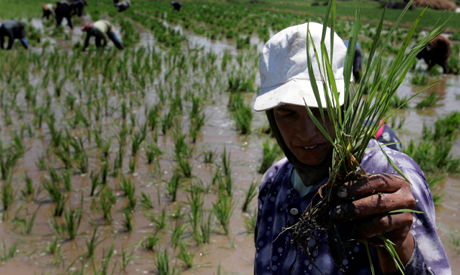Egypt plans strategic rice cultivation
Land allocated for rice cultivation was slightly reduced this year to 1.074 million feddans, down from 1.084 million feddans in recent years. Rice, a summer crop cultivated between April and October, is one of the highest water-consuming crops, which is why the government is regulating its cultivation.
This year, rice cultivation will be limited to nine governorates, Alexandria, Beheira, Gharbiya, Kafr Al-Sheikh, Damietta, Sharqiya, Ismailia, and Port Said.
Some four million tons of rice are expected to be harvested, according to the Ministry of Agriculture. Additional land may also be cultivated with rice in violation of ministry regulations. This land is estimated to range between 500,000 and 750,000 feddans.
Such factors drove the US Department of Agriculture to estimate a drop in Egypt’s rice production to its lowest level since 2018, or by 550,000 tons. While it did not specify the quantity of this year’s production, the department said consumption was estimated to stand at 3.9 million tons.
In March, Egypt’s parliament approved a new law regulating irrigation to eliminate the illegal cultivation of rice by toughening up penalties on violators who could face fines of between LE3,000 and LE10,000 on each illegally cultivated feddan of land or imprisonment for no more than six months.
However, a delay in issuing the executive regulations of the law has put off its activation for this year.
According to a statement by Prime Minister Mustafa Madbouli in March, the decision aims to engage farmers in the responsibility of reducing water consumption, rather than collect revenues for the government.
Head of the Farmers Syndicate Hussein Abu Saddam commended the system applied in the new law, which reduces the fines the earlier they are paid. Farmers receive a 60 per cent discount on fines if they are paid before 30 June and a 40 per cent reduction if they are paid prior to September.
Land in violation of the law is calculated by irrigation engineers and via satellite imaging, said a spokesman for the Ministry of Irrigation. Last year, the government allocated 724,000 feddans for irrigation by Nile water, 150,000 feddans with treated agricultural waste water, and 200 feddans to be cultivated with dry rice which does not consume much water.
Figures released by the Central Agency for Public Mobilisation and Statistics (CAPMAS) in February put the land cultivated with rice at 1.3 million feddans in 2018-19, up from 0.9 million feddans the year before.
Some 4.8 million tons of rice were produced in 2018-19, up from 3.1 million tons in 2017-18, an increase of around 54 per cent.
Mustafa Al-Naggari, a member of the Agriculture Export Council, said Egyptian consumption habits had changed over the past two years, reducing consumption of the staple rice crop and allowing the state to stock up on rice for local consumption for the next nine months.
He lauded the state’s decision to stock up on strategic goods for six months, instead of three months. The prices of locally produced crops such as wheat, rice, and sugar were stable, he said, adding that goods that had witnessed an increase in price were those that depend on fodder, such as meat, due to a global rise in fodder prices.
Ragab Shehata, head of the Rice Division at the Egyptian Federation of Industry, attributed the stability of the price of rice to the strategy drawn up by the Ministry of Supply, ensuring a continuous supply all year round.
He explained that the ministry would be receiving last year’s rice until the end of September and that the supply of the new harvest would begin in the second half of August and end by December 2022.
The Ministry of Supply is the only body that has been buying rice since 2008. Egypt had only needed to import rice in 2018 due to the smaller harvest, Shehata said, adding that the country was not expected to import rice this or next year as last year’s production has not been completely consumed.

